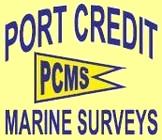 Port Credit Marine Survey & Yacht Delivery |
1. The Boat. |
 Port Credit Marine Survey & Yacht Delivery |
1. The Boat. |
| Almost every diesel-powered boat I have ever surveyed or delivered could make this trip however;
our preferences while not extravagant are
a little beyond “basic”. Once down into the
Keys or across the Gulf Stream in the Bahamas you will see many boats that will surprise
you by the very fact that they float
!
From 26’ plywood sailboats whose complete
suite of electronics consists of a
Sony Walkman
to home made trawlers with parts of
a sailboat
hull grafted to the sides like the
one in
the photo at right. Whether power or sail almost any sound vessel
with a reliable engine can successfully
complete
this voyage. All else are matters |
 If he can do it. You can do it |
| Motor yachts with a single station and canvas
enclosures on the flying bridge usually have
plastic windscreens with no wipers, making
visibility poor through salt spray and rain.
Getting up and down from such a flying bridge
poses its own problems in rough stuff. As we age just getting on and off the boat can be a problem as we clamber over high bulwarks from low docks. Or perhaps you have a transom door which means you must back into a slip (not always wise in tidal or river currents ). If you keep your dinghy on or over the swim platform, how do you get over it ? Bigger boats may carry the dinghy up high on a hardtop with a powered winch to lower it …… what a pain. You must envision how you are going to get on and off walls and fixed docks with tidal ranges of up to 9'. Preferably before you find yourself in that situation. Here is where I lay bare my blatant prejudices. I am a single diesel, powerboat guy. I enjoy sailing and agree that most power boaters are jerks, but then again I've seen too many sailboaters claim "right of way" to think they are all innocent. All boats are a compromise and we must all decide what we would like and what is essential, of course for many of us there are also budget limitations. |
 Salt spray on glass. Flexible plastic is much worse. |
| Our compromises leaned toward safety and
seakeeping ability until daughters-in-law
and grand kids showed up, then we needed
a bigger boat and had to give up Isle of
Skye for a motoryacht. Notice I don’t use
the word seaworthy as this is a legal term
that covers the suitability of crew qualifications,
stores,equipment, spares and maintenance etc. for
a specific voyage. My preference is for a round chined displacement hull with deep narrow forefoot, full body below the water with a full keel, shallow transom and a single diesel engine. The round chines mean it has a lower initial stability than hard chines and will roll a little more but have much more ultimate stability. We have had “Isle of Skye” lying on her side and she came back up …. not likely in a Monk 36. I want a boat that can handle rough seas but again this is subjective. I know people who gave up boating after a two hour trip from Toronto Island to Port Credit in 6’ waves. I know others who sneeze at my definition of rough seas being 12 footers. We have crossed the Gulf Stream in 35 knot southerlies which was miserable in the extreme but we never worried about our safety. We have run from Oswego to Toronto with 16’ waves on the stern and never lost a drop of coffee…… ( I once tried this delivering a 460 Sea Ray and had to turn back after burying her). Displacement hulls are slow (and cheap to run) but we are out here to slow down so let the sport fishers and Grand Banks pseudo trawlers knock you out of the channel as they rip by at 18 knots and be comforted by the fact you are using less than 2gph to their 30gph or more. Many are staunch believers in twin engines but my ancestors ran whiskey from the north east coast of Scotland to Iceland in 40’ wooden trawlers with you guessed it single engine diesel, round chined displacement hulls. Even with a keel (usually tiny), two props hanging down are just too exposed for me. The most common cause of diesel breakdown is fuel related and if you feed bad fuel through clogged filters it does not matter how many engines you have, none of them will work. |
 Wide side decks close to the water makes talking to neighbours easy.  Dock level door and wide side decks. Easy on ol' folks and the dog |
||
| Gasoline powered boats can and do make this trip but the expense is a killer and many have to fuel up every day which means you spend a lot of time looking for fuel docks. The classic aft cabin trawler style looks salty but tall people may get tired of crouching to enter the short side doors. Galley up vs. galley down, does the cook want a view ? This might not seem like a big deal but some feel strongly about it. Helm visibility astern is another concern in the rivers and narrow waterways as it helps to know when that 50’ sport fisher is going to drag a huge wake across your aft quarter( you can buy a video camera and monitor for about $100.00 ). Give a lot of thought to what you want before you buy and you’ll be a happier cruiser. | |||
 Stupid and dangerous when this wake hits
your stern quarter Stupid and dangerous when this wake hits
your stern quarter if you don’t see it coming. |
 This pseudo trawler idiot is waving to us as his wake is about to push us out of the channel |
| Chapter 2. Power & Sail Differences. Back to Index 
|